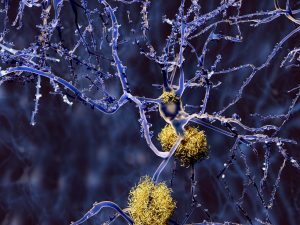 Alzheimer’s disease and type 2 diabetes share the amyloidosis link. Amyloidosis is the accumulation of amyloids, which are proteins that fold incorrectly. When proteins that are normally soluble in water are not folded correctly, they become insoluble and deposit in organs and tissues, disrupting the normal function.
Alzheimer’s disease and type 2 diabetes share the amyloidosis link. Amyloidosis is the accumulation of amyloids, which are proteins that fold incorrectly. When proteins that are normally soluble in water are not folded correctly, they become insoluble and deposit in organs and tissues, disrupting the normal function.
The researchers from Uppsala University in Sweden found brain amyloid can motivate the growth of fibrils (fine fiber) in the murine pancreas.
Advertisement
Type 2 diabetes patients normally have Islet amyloid polypeptide (IAPP). Studies have shown that accumulation of IAPP can lead to brain cell death.
Researcher Gunilla T. Westermark, said in a news release, “Several soluble proteins are amyloid forming in humans. Independent of protein origin, the fibrils produced are morphologically similar. There is a potential for structures with amyloid-seeding ability to induce both homologous and heterologous fibril growth. Heterologous seeding between IAPP and beta-amyloid may represent a molecular link between [Alzheimer’s disease] and [type 2 diabetes].”
Studies have shown that type 2 diabetes patients have double the risk of developing Alzheimer’s disease, and the findings from the Swedish study reveal amyloidosis may be the link between the two conditions.
“It is not clear if IAPP found in brain is locally produced or derived from pancreatic beta-cells. Cross-seeding by other amyloid aggregates or perhaps by other types of aggregates offers one possible mechanism for initiation of amyloid formation. Interactions between amyloid and other aggregation-prone proteins may be of great importance in the development of protein-misfolding diseases,” concluded Dr. Westermark.
Role of amyloid proteins in Alzheimer’s disease
The presence of amyloid proteins leads to brain function loss and cell death. Amyloid plaques and tangles must be present to confirm a diagnosis of Alzheimer’s disease, as they are the trademark of the condition. Amyloid plaques and tangles commonly build up in the hippocampus and neocortex, which are areas of the brain responsible for memory and cognitive function. These functions are heavily compromised in Alzheimer’s disease, and early symptoms of Alzheimer’s disease begin with forgetfulness and poorer cognitive function.
It may be therapeutically useful to target the accumulation of amyloid protein plaques and tangles as a means of preventing Alzheimer’s disease or slowing down its progression. To create such treatment methods, more research must be done to uncover how these plaques and tangles are formed.
Related Reading:
Urine odor can help early detection of Alzheimer’s disease
Researchers from the Monell Center recently collaborated with the U.S. Department of Agriculture (USDA) and other institutions to do a study on odor as a biomarker for Alzheimer’s disease. The study was conducted on mouse models. Continue reading…
Advertisement
Brain tangles in type 2 diabetes point to Alzheimer’s disease
Until very recently, tau tangles in the brain were associated with Alzheimer’s disease, but now a recent study out of Australia links tangle buildup in the brain to type 2 diabetes. According to the author of the study Dr. Velandai Srikanth, who is also an associate professor and specialist senior geriatrician at Monash University in Melbourne, diabetes may be linked to the buildup of “tangles” in the brain, separate from Alzheimer’s disease. Continue reading…
Sources:
https://alzheimersnewstoday.com/2015/02/26/amyloidosis-links-type-2-diabetes-and-alzheimers-disease/
http://www.news-medical.net/news/20150217/Study-shows-amyloid-formation-may-link-type-2-diabetes-and-Alzheimer-disease.aspx
http://www.dmso.org/articles/alzheimers/alzheim1.htm
